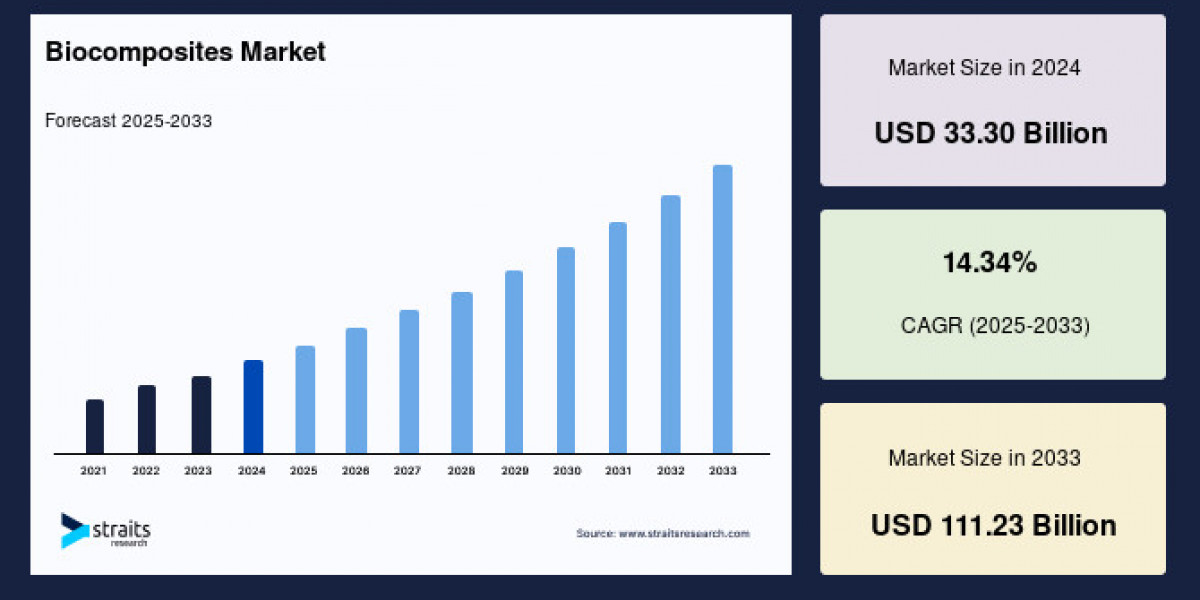The global biocomposites market is witnessing rapid expansion, fueled by the rising demand for sustainable, eco-friendly, and high-performance materials across diverse industries. Biocomposites are materials made by combining natural fibers with biodegradable polymers, offering a renewable alternative to conventional composites that often rely on petroleum-based polymers and synthetic fibers. They are increasingly recognized for their reduced environmental footprint, versatility, and ability to meet evolving industrial and consumer needs.
The global biocomposites market size was valued at USD 33.30 billion in 2024 and is estimated to reach from USD 38.07 billion in 2025 to USD 111.23 billion by 2033, growing at a CAGR of 14.34% during the forecast period (2025–2033). The growth of the market is attributed to rising demand for eco-friendly materials.
Market Overview
Biocomposites combine the strength and durability of natural fibers with the flexibility and versatility of polymers. Commonly used natural fibers include wood, flax, hemp, jute, sisal, and kenaf, while biopolymers like polylactic acid (PLA), starch-based polymers, cellulose, and polyhydroxyalkanoates (PHA) are widely employed as matrices. The resulting materials are lightweight, biodegradable, and environmentally friendly, making them suitable for applications in transportation, construction, consumer goods, electronics, and packaging.
The adoption of biocomposites is also driven by stringent environmental regulations and growing consumer preference for eco-conscious products. Industries are increasingly seeking materials that not only reduce carbon emissions but also maintain or enhance product performance.
Key Drivers of Market Growth
1. Environmental Sustainability and Regulatory Support
The push towards sustainability is a primary driver of the biocomposites market. Governments worldwide are implementing policies and regulations that encourage the use of renewable, biodegradable materials in industrial and consumer applications. Biocomposites help manufacturers meet these sustainability goals by reducing reliance on petroleum-based products and minimizing waste, greenhouse gas emissions, and overall environmental impact.
2. Growing Automotive and Aerospace Applications
The transportation sector is one of the largest consumers of biocomposites. In the automotive industry, biocomposites are used for interior panels, dashboards, door panels, seat backs, and other components, providing weight reduction, improved fuel efficiency, and recyclability. Aerospace applications utilize biocomposites for interior cabin components, lightweight structural elements, and insulation, enhancing energy efficiency while meeting strict safety and performance standards.
3. Expansion in Construction and Infrastructure
The construction sector increasingly adopts biocomposites for decking, flooring, panels, roofing, insulation, and structural applications. Biocomposites offer benefits such as durability, moisture resistance, termite resistance, and fire retardancy, making them suitable alternatives to wood and conventional composites. They also align with the growing demand for green building practices and sustainable architecture.
4. Technological Advancements and Material Innovations
Continuous research and development in biocomposite technologies are driving market growth. Innovations include hybrid composites, nanocomposites, and fiber-treated polymers that enhance mechanical strength, thermal stability, and durability. Additive manufacturing (3D printing) with biocomposites is emerging as a promising technology for creating customized, lightweight components across various industries.
5. Rising Consumer Awareness and Demand for Eco-Friendly Products
Increasing consumer awareness about environmental sustainability and health is encouraging the adoption of biocomposite-based products in packaging, electronics, consumer goods, and lifestyle products. Biocomposites provide eco-friendly alternatives without compromising on aesthetics, strength, or usability, catering to the growing green consumer segment.
Market Segmentation
By Fiber Type:
Wood Fiber: Dominates due to availability, cost-effectiveness, and versatility.
Non-Wood Fiber: Includes flax, hemp, jute, sisal, and kenaf, valued for lightweight, high-strength applications.
By Polymer Type:
Natural Polymers: Starch, cellulose, PLA, and PHA, favored for biodegradability and renewable sourcing.
Synthetic Polymers: Biodegradable polyesters and modified resins, used for enhanced mechanical properties.
By Product Type:
Green Biocomposites: Fully renewable and biodegradable materials.
Hybrid Biocomposites: Combination of renewable and conventional materials for performance optimization.
By End-User Industry:
Automotive & Transportation
Aerospace & Defense
Construction & Infrastructure
Consumer Goods & Electronics
Packaging & Food Industry
Healthcare & Medical Devices
By Region:
Asia-Pacific: Dominates due to rapid industrialization, government incentives, and growing manufacturing hubs in China and India.
North America: Strong market growth fueled by technological advancements, automotive innovation, and environmental initiatives.
Europe: Steady market expansion supported by sustainability policies, automotive and aerospace applications, and renewable energy adoption.
Latin America and Middle East & Africa: Emerging markets driven by infrastructure development and increasing industrialization.
Challenges
Cost Competitiveness: Biocomposites often cost more than conventional composites, which can limit adoption in price-sensitive markets.
Mechanical and Performance Limitations: Some biocomposites may have lower strength or durability compared to synthetic composites, requiring material optimization.
Supply Chain Constraints: Limited availability of high-quality natural fibers and biopolymers can impact production scalability.
Opportunities
Emerging Applications: Expanding use in electronics, packaging, medical devices, and aerospace interiors offers significant growth potential.
3D Printing and Advanced Manufacturing: Biocomposites compatible with additive manufacturing enable lightweight, customized, and sustainable components.
Sustainable Packaging: Increasing demand for biodegradable packaging presents an opportunity for biocomposite adoption in consumer goods and food industries.
R&D Innovations: Investment in enhancing mechanical, thermal, and barrier properties can drive wider adoption across performance-critical sectors.
Regional Insights
Asia-Pacific dominates due to strong automotive, aerospace, and construction industries combined with abundant natural fiber availability. China and India lead the market, driven by industrial growth and favorable government policies promoting sustainability.
North America is witnessing growth fueled by the automotive and aerospace sectors, coupled with consumer demand for green products and robust R&D initiatives.
Europe continues to expand steadily with a strong focus on environmental sustainability, renewable materials adoption, and innovations in green building practices.
Conclusion
The biocomposites market is poised for robust growth, driven by technological innovations, sustainability trends, and increasing industrial applications. As global industries transition toward environmentally friendly alternatives, biocomposites are emerging as a preferred material, offering a combination of performance, versatility, and eco-consciousness. Ongoing research, strategic collaborations, and expansion into emerging applications will ensure that biocomposites remain a key player in shaping a sustainable future across automotive, aerospace, construction, consumer goods, and packaging sectors.








